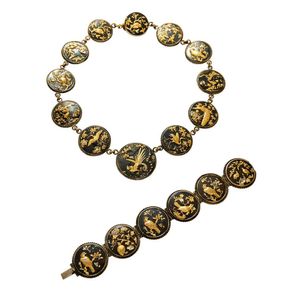19th Century Shakudo Gilt Metal Necklace and Bracelet Set
shakudo gilt metal necklace and bracelet, 19th century; comprising of: a necklace composed of 12 circular plaques, each inlaid with copper and 9ct gold plated shakudo-work, depicting various species of bird, including crane, pheasant and quail, amongst flowers and foliage within borders of corded decoration; the six plaque bracelet en suite, necklace length 455 mm, bracelet length 180 mm, total gross weight approximately 139 grams (2).
You must be a subscriber, and be logged in to view price and dealer details.
Subscribe Now to view actual auction price for this item
When you subscribe, you have the option of setting the currency in which to display prices to $Au, $US, $NZ or Stg.
This item has been sold, and the description, image and price are for reference purposes only.
- Shakudo - Japanese shakudo is a traditional alloy that has been used in Japan for centuries. It is primarily composed of copper and gold, with the copper serving as the base metal and the gold adding a yellowish hue to the alloy. Shakudo is known for its beautiful dark blue-black or black colour, which is achieved through the addition of a small amount of a patina-inducing element like silver or arsenic.
The word "shakudo" itself can be translated as "red copper" in Japanese, referring to the reddish-brown color of the pure copper base metal before it is patinated. The gold content in shakudo is usually around 4-10%, but this can vary depending on the specific purpose or desired appearance.
Shakudo has been traditionally used in various forms of decorative arts and crafts in Japan. It is particularly associated with metalwork, including sword fittings (such as tsuba, menuki, and kashira), jewelry, and small ornamental objects. The alloy's dark color provides a striking contrast to other metals like silver or gold, making it ideal for intricate inlay work or as a background for other decorative elements.
This item has been included into following indexes:
